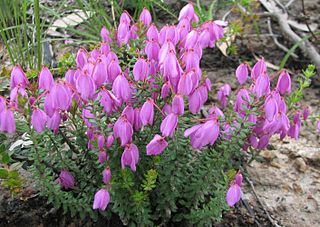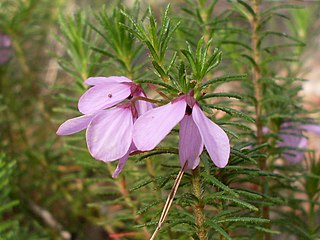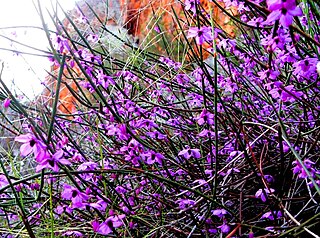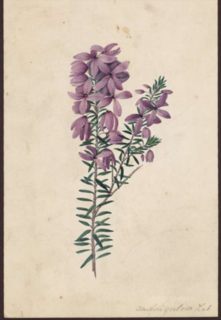
Tetratheca is a genus of around 50 to 60 species of shrubs endemic to Australia. It is classified in the botanical family Elaeocarpaceae, now known to encompass the family Tremandraceae, which the genus originally belonged to. It occurs throughout extratropical Australia, and has been recorded in every mainland state except the Northern Territory.

Tetratheca bauerifolia, commonly known as heath pink-bells, is a flowering plant in the family Elaeocarpaceae and is endemic to eastern Australia. It is a small compact shrub with pink-mauve flowers.
Tetratheca paynterae, also known as Paynter's Tetratheca, is a species of plant in the quandong family that is endemic to Australia. There are two recognised subspecies.
Tetratheca deltoidea, also known as granite tetratheca, is a species of plant in the quandong family that is endemic to Australia.
Tetratheca similis is a species of plant in the quandong family that is endemic to Australia.
Tetratheca fasciculata, also known as Cronin's Tetratheca, is an extinct species of plant in the quandong family that was endemic to Australia.
Tetratheca decora, also known as black-eyed susan, is a species of plant in the quandong family that is endemic to Australia.
Tetratheca rupicola is a species of plant in the quandong family that is endemic to Australia.

Tetratheca neglecta is a species of plant in the quandong family that is endemic to Australia.
Tetratheca labillardierei is a species of plant in the quandong family that is endemic to Australia.
Tetratheca insularis is a species of plant in the quandong family that is endemic to Australia.
Tetratheca pilata is a species of plant in the quandong family that is endemic to Australia.
Tetratheca exasperata is a species of flowering plant in the quandong family that is endemic to Australia.
Tetratheca harperi, also known as Jackson Tetratheca, is a species of flowering plant in the quandong family that is endemic to Australia.

Tetratheca aphylla, also known as the Bungalbin Tetratheca, is a species of flowering plant in the quandong family that is endemic to Australia.
Tetratheca subaphylla, also known as leafless pink-bells, is a species of flowering plant in the quandong family that is endemic to Australia.

Tetratheca shiressii is a species of flowering plant in the quandong family that is endemic to Australia.
Tetratheca rubioides is a species of flowering plant in the quandong family that is endemic to Australia.

Tetratheca procumbens, also known as mountain pink-bells, is a species of flowering plant in the quandong family that is endemic to Australia.

Tetratheca ericifolia is a species of flowering plant in the quandong family that is endemic to Australia.






